APSEC Home
|
||||
| Steering Committee | ||||
Chair Paul Strooper (The University of Queensland, Australia) Members Mikio Aoyama (Nanzan University, Japan Sungdeok (Steve) Cha (Korea University, Korea) William C. Chu (Tung Hai University, Taiwan) Jin Song Dong (National University of Singapore, Singapore) Jun Han (Swinburne University of Technology, Australia) Karl R. P. H. Leung (Hong Kong Institute of Vocational Education, Hong Kong) Katsuhisa Maruyama (Ritsumeikan University, Japan) Sooyong Park (Sogang University, Korea) Danny Poo (National University of Singapore, Singapore) Pornsiri Muenchaisri (Chulalonghorn University, Thailand) Shamsul Sahibuddin (Universiti Teknologi Malaysia, Malaysia) Ashish Sureka (Indraprastha Institute of Information Technology Delhi IIITD, India) Emeritus Members Doo-Hwan Bae (KAIST, Korea) Paul Bailes (University of Queensland, Australia) Kyo-Chul Kang (POSTECH, Korea) Karl Reed (La Ttrobe University, Australia) Motoshi Saeki (Tokyo Institute of Technology, Japan) Tetsuo Tamai (University of Tokyo, Japan) |
||||
| Current and Past Conferences | ||||
| 23 | APSEC 2015 | Dec. 1-5, 2015 New Delhi, India |
Proceedings: IEEE Digital Library |
|
| 22 | APSEC2014 | Dec. 1-4, 2014 Jeju, Korea |
Proceedings: IEEE Digital Library |
|
| 21 | APSEC2013 | Dec. 2-5, 2013 Bangkok, Thailand |
Proceedings: Digital Library (IEE Xplore, Computer Society) |
|
| 20 | APSEC2012 | Dec. 4-7, 2012 Hong Kong, China |
Proceedings: Digital Library (IEE Xplore, Computer Society) |
|
| 18 | APSEC2011 | Dec. 5-8, 2011 Ho Chi Minh, Vietnam |
Proceedings: Digital Library (IEE Xplore, Computer Society) |
|
| 17 | APSEC2010 | Dec. 1-3, 2010 Sydney, Australia |
Proceedings: Digital Library (IEE Xplore, Computer Society) |
|
| 16 | APSEC2009 | Dec. 1-3, 2009, Bayview Beach Resort, Penang, Malaysia |
Proceedings Digital Library (IEE Xplore, Computer Society) |
|
| 15 | APSEC 2008 | Dec. 3-5, 2008, Beijing, China |
Proceedings (IEEE Computer Society Digital Library) |
 |
| 14 | APSEC 2007 | Dec. 5-7, 2007 Nagoya, Japan |
Proceedings (IEEE Computer Society Digital Library) |
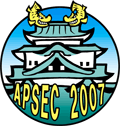 |
| 13 | APSEC 2006 | Dec. 6-8, 2006, Bangalore, India |
Proceedings (IEEE Computer Society Digital Library) |
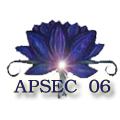 |
| 12 | APSEC 2005 | Dec. 15-17, 2005 Taipei, Taiwan |
Proceedings (IEEE Computer Society Digital Library) |
|
| 11 | APSEC 2004 | Nov. 30-Dec. 3, 2004 Busan, Korea |
Proceedings (IEEE Computer Society Digital Library) |
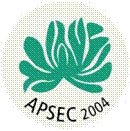 |
| 10 | APSEC 2003 | Dec. 10-12, 2003 Chiang Mai, Thailand |
Proceedings (IEEE Computer Society Digital Library) |
 |
| 9 | APSEC 2002 | Dec. 4-6, 2002 Gold Coast, Australia |
Proceedings (IEEE Computer Society Digital Library) |
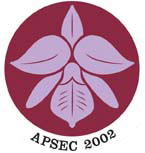 |
| 8 | APSEC 2001 | Dec. 4-7, 2001 Macao, China |
Proceedings (IEEE Computer Society Digital Library) |
 |
| 7 | APSEC 2000 | Dec. 5-8, 2000 Singapore |
Proceedings (IEEE Computer Society Digital Library) |
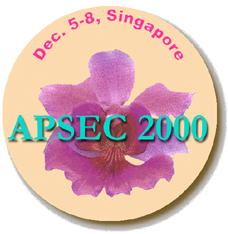 |
| 6 | APSEC '99 | Dec. 7-10, 1999 Takamatsu, Japan, |
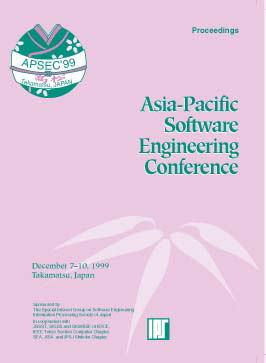 Proceedings (IEEE Computer Society Digital Library) |
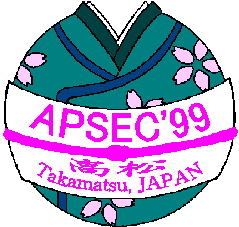 |
| 5 | APSEC '98 | Dec. 2-4, 1998 Taipei, Taiwan |
Proceedings (IEEE Computer Society Digital Library) |
 |
| 4 | APSEC '97 | Dec. 2-5, 1997 Hong Kong, China |
Proceedings (IEEE Computer Society Digital Library) |
|
| 3 | APSEC '96 | Dec. 4-7, 1996 Seoul, South Korea |
Proceedings (IEEE Computer Society Digital Library) |
|
| 2 | APSEC '95 | Dec. 6-9, 1995 Brisbane, Australia |
Proceedings (IEEE Computer Society Digital Library) |
|
| 1 | APSEC '94 | Dec. 7-9, 1994 Tokyo, Japan |
Proceedings (IEEE Computer Society) |
|